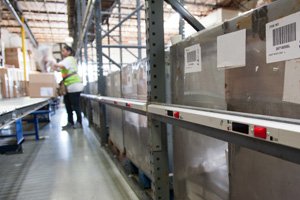
Synergy of Information and Material Handling Automation is Key in Supply Chain Management
SPS Chauhan | 08 May 2012
The term ‘Automation’ owes its origin to the word ‘Automaton,’ meaning self moving machinery or a routine human act without intelligence. Automation in the supply chain means the task can be performed by man and machine, in coherence, without intelligence. However, this does not mean the people working will not use their intelligence. It means that the processes and procedures are standardized to a point where the decisions are not based on personal intelligence or gut feeling but on predefined parameters, taking into account “what if“ situations to guide the operator or machine throughout the task.
Automation does not necessarily mean replacing man power with artificial intelligence. It means facilitating humans to base their decisions on well-defined parameters to be more efficient. Take the example of transferring material from one point to another. One could either have it transferred manually or use some computerized conveyor to do the job. This will not necessarily lead to manpower reduction. The conveyor system will be developed to work in tandem with the operator based on parameters of material to be transferred, cycle time, distance to be covered, etc.
Automation means providing the operator with a tool, which will help him perform his duty--in this case transferring material--much faster and without damages. This essentially does not qualify as complete automation but can be termed as a first step toward achieving it. In this chain, the last step could be robots that can pick the material, transfer it to a desired location, and store it.  In any organization, the automation of information generation, processing, and transfer is as important as automation of physical activities.
In any organization, the automation of information generation, processing, and transfer is as important as automation of physical activities.
The benefits of timely and accurate information in the supply chain are the driving force behind automation. A logistics manager wants better control over carriers and shipments. The warehouse manager wants better control over inventory. A service rep wants to provide the customer with an order status update. The board wants a scorecard showing where things are moving and where they are standing. A huge amount of data is generated, collected, processed, and then disbursed to support these functions throughout the organization.
This process of collecting data at the source, converting it to meaningful information, and then disbursing it can be automated, and there are numerous types of hardware and software available to do this. To achieve meaningful automation, the automation of material handling and the automation of information should go hand in hand. The process of generating the right information and then distributing it across the company--so the right material is produced, stored, and eventually shipped--can be automated to improve the overall workings of the company.
Automation of information and material handling directly effect the bottom line of the company. If the company can generate and percolate the right information to the right people at the right time, resulting in proper material handing and movement, it will provide better efficiency in the complete chain. This will result in better customer service and eventually improve the company performance and bottom line.
 In an ever changing business scenario and increasing competition, the right amount of automation for information and material handling can provide the essential edge to any company in moving ahead in a globally competitive market. The automation can help the company in improving cycle time, reducing damages, providing a higher availability of information, and thus improving customer satisfaction. Before any company embarks on automation, they should always ask three basic questions:
In an ever changing business scenario and increasing competition, the right amount of automation for information and material handling can provide the essential edge to any company in moving ahead in a globally competitive market. The automation can help the company in improving cycle time, reducing damages, providing a higher availability of information, and thus improving customer satisfaction. Before any company embarks on automation, they should always ask three basic questions:
- What do we want to achieve from automation?
- Up to what level, do we want to automate?
- What are the benefits of automation to both the company and final customer?
Answering these three questions will help the company:
- Choose the right processes to automate
- Determine the right mix of automation and manual processes
- Optimize man power and other resources to achieve the final goal of automation
The future of business will be dominated by companies who are able to provide customers with customized service both in terms of merchandise sold and information within a short period of time and without mistakes. Accurate and efficient service can only be achieved with synergy in automation of information and material handling.
Comments
Jason says:
8/28/2018 10:08 AM
Good Read. I always enjoy a good material handling article. Thanks.
Leave a Reply
Your email address will not be published.
Comment
Thank you for your comment.